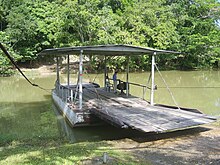Mopan River
| Mopan River | |
|---|---|
 Mopan River atBullet Tree Falls | |
| Location | |
| Countries | GuatemalaandBelize |
| Physical characteristics | |
| Source | |
| • location | Guatemala |
| • coordinates | 16°58′13″N89°12′40″W/ 16.97021°N 89.21119°W |
| • elevation | 850 m (2,790 ft) |
| Mouth | |
• location | Belize(affluent ofBelize River) |
• coordinates | 17°10′39″N89°04′51″W/ 17.17742°N 89.08082°W |
• elevation | 50 m (160 ft) |
TheMopan Riveris a river inCentral Americaspanning thePetén DepartmentofGuatemalaand theCayo DistrictofBelize.It merges with theMacal Riverat Branch Mouth, Belize, forming theBelize River,which ultimately discharges into theCaribbean Sea.The drainage area of the combined watershed is 9,434.2 km2(3,642.6 sq mi).[1]Tributaries of the Mopan include Chiquibul Branch, Ceiba Grande, Salisipuedes, and Delores.[1][2]
Hydrology
[edit]The Mopan River's rate of discharge has been measured regularly since 1981 at the river gauge station inBenque Viejo, Belize.[3]According to these measurements, the river's annual mean discharge varies between 20 and 40 m3/s.[1]The highest rate ever recorded was 404 m3/s in November 1990.[3]
Although the Mopan may contribute to downstream flooding during the rainy season, it responds much slower to rain storms than the other major tributary of the Belize River, theMacal.[3]Both rivers yield similar volumes on average, but the Mopan watershed is less mountainous than the Macal watershed, giving it less intense flood waves.[3]
Pollution
[edit]The combined Mopan River/Belize River watershed contains 11% of the population of the Peten District in Guatemala and 45% of the population of Belize.[4]These populations depend on the river for drinking water and other domestic uses; however,water qualityis degraded fromsediment,nutrientloading, untreatedsewagedischarge,pesticidesand other toxins. The major source of degradation is the extensivedeforestationin the upper reaches and non-sustainable agriculture.Karper and Boles have asserted:[4]"The greater Mopan/Belize River Catchment provides a prime example of a watershed under stress from extensive non-sustainable agricultural practices that have occurred within the region over the past three decades."Slash-and-burnagricultural practices by native peoples are contributing to such watershed degradation.
Maya sites
[edit]
Several importantMayaarchaeologicalsites are situated along the Mopan River. From upriver to downriver, these includeUcanal,Arenal,Xunantunich,Actuncan,andBuenavista del Cayo.Several of these sites and associated settlement areas have been studied as part of the Mopan Valley Archaeology Project. Archaeological surveys have identified the remains of several hundred ancient structures in these areas, with the highest density occurring in the area near Xunantunich.[5]
Recreation
[edit]Popular activities on the Mopan River includekayakingandriver tubing.[6]
References
[edit]- ^abc"Belize River".BERDS.Archived fromthe originalon 6 February 2012.
- ^Schwartz, Norman B. (1990).Forest Society: A Social History of Petén, Guatemala.Philadelphia: University of Pennsylvania Press. p. 16.ISBN0812213165.
- ^abcdWagenseil, Ross (November 1999).Investigations of the Belize River: Modeling Flow Overland to the Macal Tributary.Organisation of American States.
- ^abJes Karper and Ed Boles,Human Impact Mapping of the Mopan and Chiquibul Rivers within Guatemala and Belize(2003)Archived2007-09-27 at theWayback Machine
- ^Yaeger, Jason; Peuramaki-Brown, Meaghan; Dykstra, Christina; Kurnick, Sarah; Salgado-Flores, Sebastián (2011). "Political Dynamics in the Mopan River Valley: Recent Research in the Buenavista Del Cayo Hinterlands".Research Reports in Belizean Archaeology.8.Belmopan, Belize: Institute of Archaeology: 31–44.
- ^Rough Guide to Belize.Rough Guides. 2014. p. 144.ISBN1409349608.
External links
[edit] Media related toMopan Riverat Wikimedia Commons
Media related toMopan Riverat Wikimedia Commons
